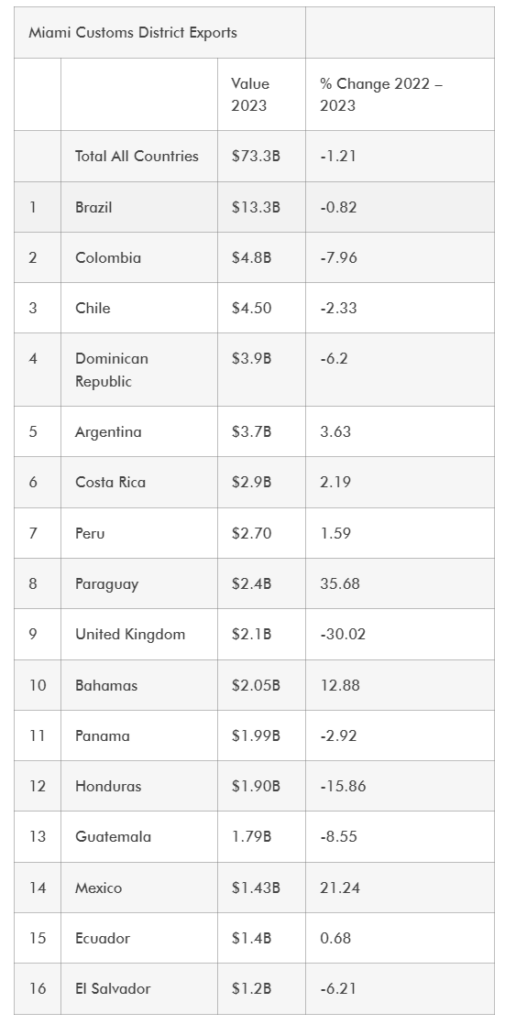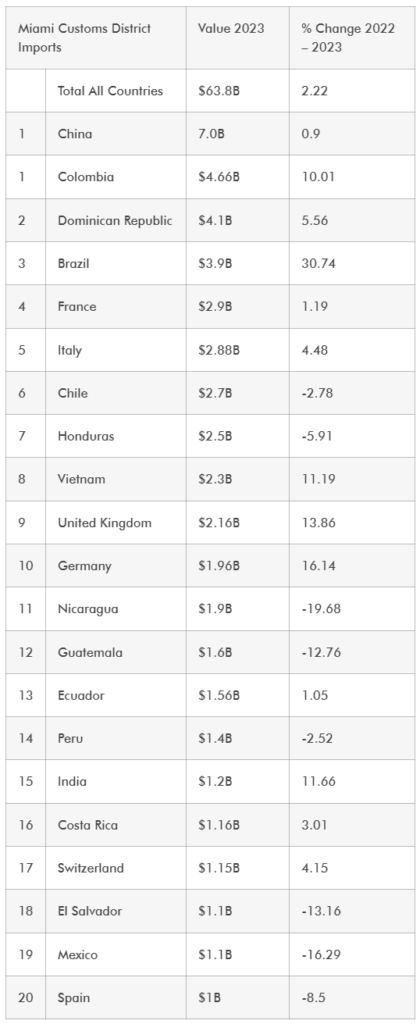You are here:
Home / Re-globalization and Its Implications for Miami
By Alice Ancona
Trade, like water, flows through the path of least resistance. 2023 marked a year of resistance, challenges, and transformations in global trade patterns.
Here’s a summary of the impacts on global trade:
So how does this impact the Miami Customs District?
In the Miami Customs District, exports in 2023 were down by 1.2% or about $895 million and they are down in key export markets. U.S Exports were down by 2.2%. For the Miami Customs District, Latin America and the Caribbean are the primary destinations for our exports, and their performance in 2023 was mixed. The most notable are Honduras (down by 16%) and Colombia (down by 8%), Paraguay (up by 35%), Mexico (up by 21%), and the Bahamas (up by 13%).
The Miami Customs District has several countries that are members of what I like to call the “Billion Dollar Club”. These are export destinations that average over a billion in either imports and/or exports for several years. On the export side they are as follows:
| Miami Customs District Exports | |||
| Value 2023 | % Change 2022 – 2023 | ||
| Total All Countries | $73.3B | -1.21 | |
| 1 | Brazil | $13.3B | -0.82 |
| 2 | Colombia | $4.8B | -7.96 |
| 3 | Chile | $4.50 | -2.33 |
| 4 | Dominican Republic | $3.9B | -6.2 |
| 5 | Argentina | $3.7B | 3.63 |
| 6 | Costa Rica | $2.9B | 2.19 |
| 7 | Peru | $2.70 | 1.59 |
| 8 | Paraguay | $2.4B | 35.68 |
| 9 | United Kingdom | $2.1B | -30.02 |
| 10 | Bahamas | $2.05B | 12.88 |
| 11 | Panama | $1.99B | -2.92 |
| 12 | Honduras | $1.90B | -15.86 |
| 13 | Guatemala | 1.79B | -8.55 |
| 14 | Mexico | $1.43B | 21.24 |
| 15 | Ecuador | $1.4B | 0.68 |
| 16 | El Salvador | $1.2B | -6.21 |

The newest member is the UK. For the past 2 years it has been an over $2 Billion export market for the Miami Customs District.
Comeback markets to watch are UAE and Trinidad & Tobago with consistent double-digit growth for the past two years. Both were billion-dollar club members from 2013-2017.
On the import side, 2023 saw slight growth of 2.2%. U.S imports were down by .2%, which is negligible. For the Miami Customs District, China was the most notable change as growth barely reached 1%. Notable changes are Nicaragua (down by almost 20%), Mexico (down by 16%), and El Salvador (down by 13%). Our import markets are much more diversified than our export markets. Colombia was up by 10%, Brazil was up by 30%, UK was up by 14% and India and Vietnam up by 11%.
Miami Customs Districts’ “Billion Dollar Club” import markets are as follows:
| Miami Customs District Imports | Value 2023 | % Change 2022 – 2023 | |
| Total All Countries | $63.8B | 2.22 | |
| 1 | China | 7.0B | 0.9 |
| 1 | Colombia | $4.66B | 10.01 |
| 2 | Dominican Republic | $4.1B | 5.56 |
| 3 | Brazil | $3.9B | 30.74 |
| 4 | France | $2.9B | 1.19 |
| 5 | Italy | $2.88B | 4.48 |
| 6 | Chile | $2.7B | -2.78 |
| 7 | Honduras | $2.5B | -5.91 |
| 8 | Vietnam | $2.3B | 11.19 |
| 9 | United Kingdom | $2.16B | 13.86 |
| 10 | Germany | $1.96B | 16.14 |
| 11 | Nicaragua | $1.9B | -19.68 |
| 12 | Guatemala | $1.6B | -12.76 |
| 13 | Ecuador | $1.56B | 1.05 |
| 14 | Peru | $1.4B | -2.52 |
| 15 | India | $1.2B | 11.66 |
| 16 | Costa Rica | $1.16B | 3.01 |
| 17 | Switzerland | $1.15B | 4.15 |
| 18 | El Salvador | $1.1B | -13.16 |
| 19 | Mexico | $1.1B | -16.29 |
| 20 | Spain | $1B | -8.5 |

Newest additions to the list are Costa Rica and India. Markets to watch are Malaysia and Turkey. Both have shown some interesting growth over the past several years. Last year trade with Turkey slowed, likely due to geopolitical reasons.
Near term headwinds and tailwinds to lookout for:
A record number of voters are expected to participate in national elections across at least 64 countries, including the European Union and six Latin American nations: El Salvador, Panama, the Dominican Republic, Mexico, Venezuela, and Uruguay. All together, these regions represent around 49% of the global population, and the election outcomes could affect future trade patterns.
Changes in what is traded are also noteworthy, with many shifts driven by policy. For instance, global climate commitments are on the rise. The Biden administration’s recent announcement of new automobile emissions standards could significantly boost production and trade of electric and hybrid vehicles. Electric vehicles (including hybrid vehicles) drove global trade in environmental goods in 2023, growing by 60% according to the UN.
The strong U.S. dollar and robust American economy are impacting exports by making them more expensive in foreign markets. Although overall exports remain strong, smaller exporters are often the first to feel the effects of these challenges.
So, what does re-globalization mean for the Miami Customs District?
As trade patterns evolve, we can expect more diversification in imports. Miami serves as a crucial entry point for the U.S., and countries like India and Vietnam illustrate the shift in production away from China. While Miami has strong connections with Latin America and the Caribbean, its ties with India and Vietnam are less established. Developing relationships and forging partnerships will be essential in capitalizing on these shifting trade patterns and expanding trade with these regions.
Geopolitics and the need for supply chain transparency and security will continue to drive additional changes in trade flows. The U.S. is taking firm steps to pivot away from China. The Biden Administration continued the Trump Administrations China policies and both parties seemed to be aligned on the path to further decouple going into this coming election cycle and beyond. There is no going back now.
The U.S.-Mexico-Canada Agreement (USMCA), which replaced the North American Free Trade Agreement (NAFTA), has bolstered trade relations between Mexico and Canada. This regional trading alliance is among the world’s most competitive and provides substantial benefits for all three countries by enhancing supply chains, increasing manufacturing, and promoting nearshoring. Mexico recently emerged as the U.S.’s top trading partner. Although trade between the Miami Customs District and Mexico is growing, it lacks a driving force like cross-border industrial production that benefits other customs districts in the U.S. Canada, on the other hand, does not rank in our top 20 for merchandise trade. Our trade with Canada is more pronounced in the services sector, where they are a key market for tourism, finance, and other services. To fully leverage the benefits of the USMCA, Miami will need to connect with the manufacturing sectors in Mexico and Canada.
In the coming weeks and months, preliminary 2023 data will be refined into final figures, providing clearer insights into trade trends. What is already apparent is the unmistakable progress of re-globalization.
Data Sources: U.S. Census Bureau, United Nations Conference on Trade and Development
Subscribe to our Newsletter!
Copyright © 2024 World Trade Center Miami, Inc. All Rights Reserved.